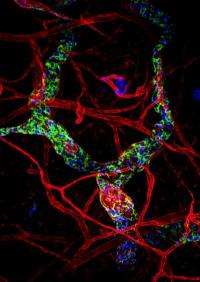Study shows how immune cells navigate through the skin by sensing graded patterns of immobilized directional cues

A research paper by the group of Michael Sixt, Assistant Professor at the Institute of Science and Technology Austria (IST Austria), published today in Science, provides new insights into how immune cells find their way through tissues. The findings provide the first evidence for directed cell migration along concentration gradients of chemical cues immobilized in tissues, a concept that has long been assumed but never experimentally proven.
Immune cells constantly patrol our body to check for foreign invaders, such as bacteria or viruses. To do so they leave the blood stream, actively crawl through tissues and finally re-enter the circulation via lymphatic vessels. Research from the laboratory of Michael Sixt elucidates how the cells are guided through tissues like the skin. It is thought that cells either sense their environment by 'touching' or 'smelling': They adhere to structural molecules like connective tissue proteins using adhesion receptors. Or they 'smell' soluble signal molecules with specialized surface receptors. Especially solutes are thought to act as directional cues as they tend to be more concentrated closer to the production source. Like one can find a flower by following its scent, cells are able to follow such soluble gradients. Both principles, touching and smelling, have been demonstrated to work in cell culture experiments. But how cell guidance functions in real tissues is still not known.
Read: New study confirms immune cells are guided by gradients
According to the new study, immune cells in mouse skin use a mixed strategy. They follow gradients of guidance cues, which are not soluble but immobilized to sugar molecules in the connective tissue. In their newly published work, the scientists around Michael Sixt visualized both the immune cells, in this case dendritic cells, and the cue, the chemokine CCL21, and recorded movies of how the cells navigate through living tissues. The researchers found that the chemokine is exclusively produced by the lymphatic vessel. From there it distributes into the surrounding tissue, forming a concentration gradient. In collaboration with Robert Hauschild and Tobias Bollenbach, two physicists at IST Austria, detailed quantitative maps of the chemokine distribution were drawn and compared with the migratory routes of the cells. Observation and quantitative prediction matched well: a cell can find the next lymphatic vessel by comparing the concentration of chemokine across its surface and then crawling towards the higher concentration. For this to work the cell only needs to be of a certain size because the gradients are noisy. A small cell would easily get trapped on a local concentration peak as it cannot "see" that there is an even higher peak nearby. To prove their concept, the scientists outcompeted the chemokine gradients in the tissue by applying excess chemokine from the outside. They found that this confuses the cells on their way to the lymphatic vessel. When they released the anchoring of the chemokine to the tissue, cells also got confused, demonstrating that the gradients are not soluble but bound to the tissue.
Michael Sixt points out: "This is the first time someone could directly visualize and quantify a chemokine gradient, and show how these gradients guide migratory cells. The finding that the guidance cue is anchored to the tissue makes a lot of sense: if it would be soluble, even a slight massage of the skin would likely cause fluid shifts and destroy the gradient. In contrast, an immobilized gradient is a permanent and robust infrastructure and rather insensitive to the fluid turbulences occurring in most tissues. It is important to understand how immune cells move and navigate. Only then can we think about strategies to alter their behavior".
More information:
ist.ac.at/research/research-groups/sixt-group/
Paper: www.sciencemag.org/content/339/6117/328.abstract

















